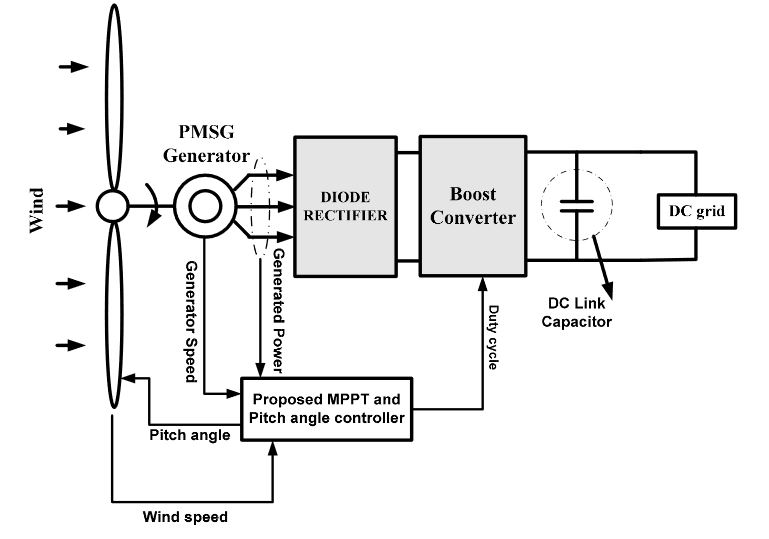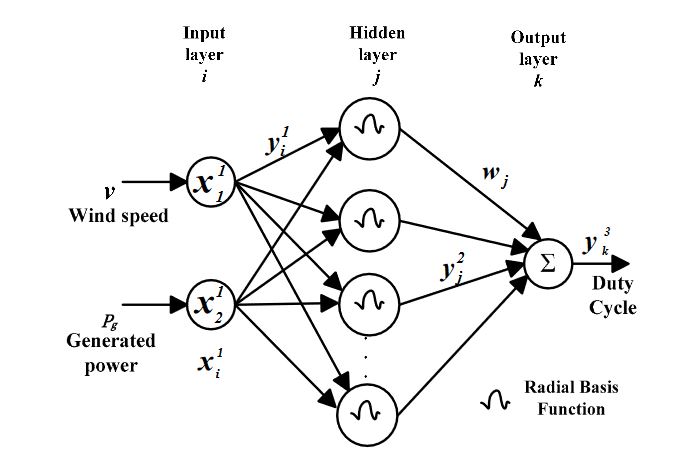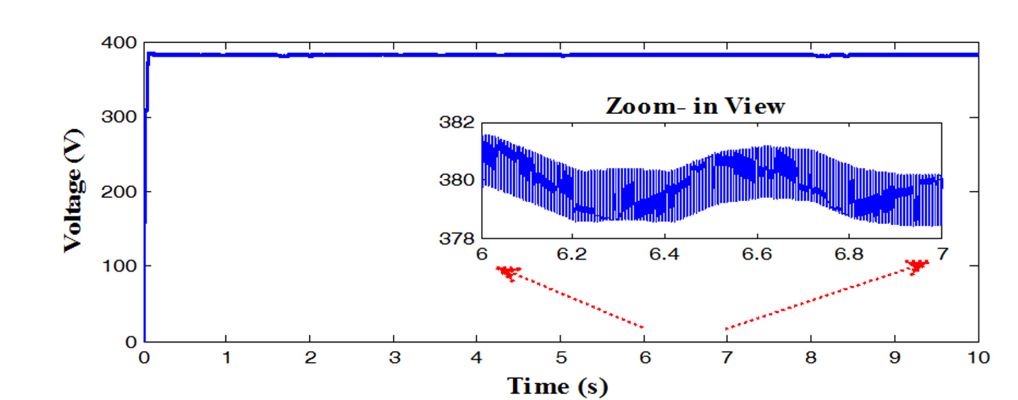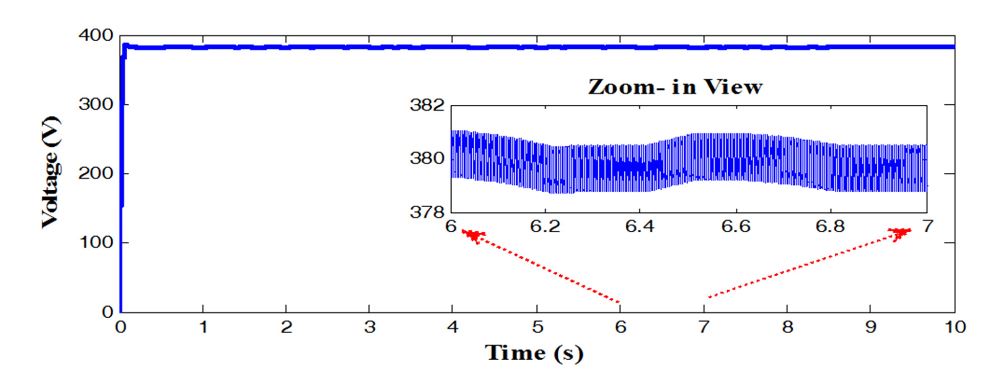ABSTRACT
In this paper, a novel co-ordinated hybrid maximum power point tracking (MPPT)-pitch angle based on a radial basis function network (RBFN) is proposed for a variable speed variable pitch wind turbine. The proposed controller is used to maximize output power when the wind speed is low and optimize the power when the wind speed is high. The proposed controller provides robustness to the nonlinear characteristic of wind speed. It uses wind speed, generator speed, and generator power as input variables and utilizes the duty cycle and the reference pitch angle as the output control variables.
The duty cycle is used to control the converter so as to maximize the power output and the reference pitch angle is used to control the generator speed in order to control the generator output power in the above rated wind speed region. The effectiveness of the proposed controller was verified using MATLAB/Simulink software.
MODELLING OF THE WIND ENERGY CONVERSION SYSTEM

Figure 3. Proposed configuration for the permanent magnet synchronous generator (PMSG) based wind energy conversion system
The configuration of the proposed WECS is shown in Figure 3. The system consists of a direct driven PMSG, diode rectifier, boost converter and a proposed hybrid control strategy for a standalone system. The boost converter is incorporated with the MPPT control strategy which generates duty cycle according to the available wind speed. The pitch angle is initiated when the wind velocity exceeds the rated wind speed. The pitch angle command controls the angle of the blade in such a way that the rotational speed of the shaft is kept at the optimum value.
CONTROL STRATEGY OF WECS

Figure 4. Proposed coordinated maximum power point tracking (MPPT) control strategy
The WECS is highly non-linear in nature, thus an efficient and complex problem solving controller is required to enhance the overall performance. In this paper, RBFN based ANN control strategy was used to predict the precise duty cycle for the MPPT controller when the wind speed was below the rated speed as well as the specific angle for the blade for the pitch angle control strategy when the wind velocity exceeded the rated value.

Figure 6. RBFN based MPPT control strategy. wind system and act appropriately
Supervised learning is implemented once the RBFN is initialized to train the system. The training method is the same as the back propagation algorithm which is used to adjust the RBFN parameters using the training patterns. The error of each layer is calculated and updated by the supervised learning algorithm in order to track the performance of the wind system and act appropriately.
RESULTS AND DISCUSSION

Figure 9. DC voltage—MPPT control strategy
Figure 9 shows the DC voltage obtained when the MPPT control strategy is used as the control strategy. As the wind variation is between 9 m/s to 16 m/s the DC voltage obtained is constant. The rated value of the DC voltage is kept as 380 V.

Figure 14. DC voltage-Proposed controller
The DC voltage of WECS obtained at the load when the proposed controller is used is shown in Figure 14. The DC voltage which is kept constant at the rated value of 380 V is achieved by using this control strategy. The wind speed variation considered here varies only from 9 m/s to 16 m/s.
Thus the rated voltage is obtained and kept constant throughout the operation. In standalone wind systems when the wind speed drops below the transition region (7 m/s in this topology), the rated voltage value also dips. Thus the wind speed should be above the transition value in order to generate a constant DC voltage.
CONCLUSIONS
In this research, a novel coordinated hybrid MPPT-Pitch angle control strategy employing RBFN based ANN technique for PMSG based WECS was proposed to enhance the overall efficiency of wind power generation in all operating regions. The proposed controller tracks the maximum power when the wind speed is below the rated wind speed and limits the output power in the high wind speed region. To develop the controller, a highly non-linear wind speed input was considered.
The wind speed, generator speed, and generated power were selected as the control input variables. The duty cycle and pitch command to the blade were considered as the controlled output variables. The selection of which output variable to be activated is based on the wind speed. In the low wind speed region, the duty cycle is generated to control the power electronics converter thus obtaining maximum available power from the wind speed. When the wind speed exceeds the rated wind velocity, the blade tends to change its angle in order to limit the output power.
Thus by using the proposed hybrid control strategy, the output power is maximized with an efficiency of 98.1% compared to 97.3% achieved using an individual MPPT control strategy and 96% using an individual control strategy in below rated wind speed; generator power can be optimized and regulated it the rated value of 3 kW in high wind speed regions. The proposed controller is a suitable alternative for the re-powering of small scale WECS, many of which have been installed in developing countries.
Source: VIT University
Authors: Ramji Tiwari | Sanjeevikumar Padmanaban | Ramesh Babu Neelakandan
>> 200+ Matlab Projects for Control System for Final Year Students
>> 80+ Matlab Projects based on Power Electronics for Engineering Students